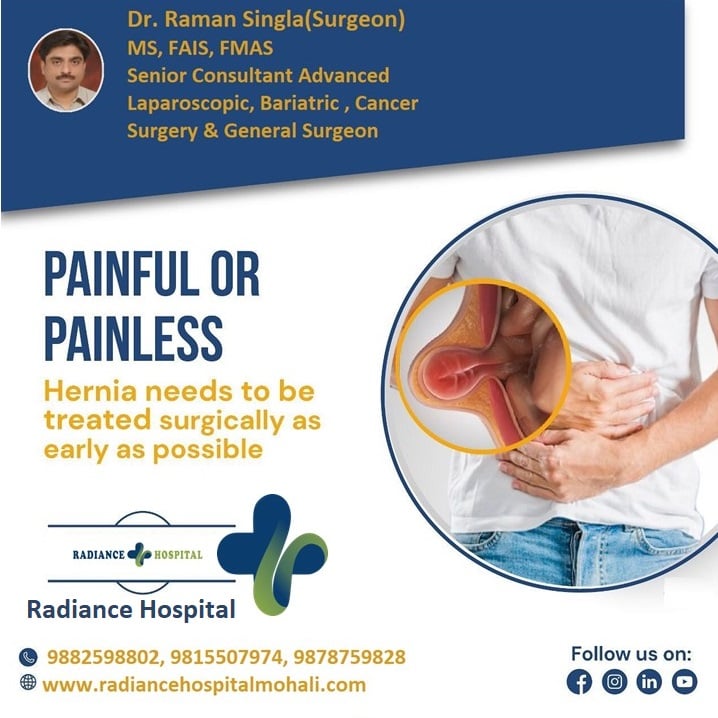
Laparoscopic hernia repair involves the use of an instrument known as a laparoscope. Only two to three small cuts are made into the abdominal wall through which laparoscope and other surgical instruments are passed into the abdomen. This surgery is often known as keyhole surgery because it is performed by making small incisions.
Hernia
A hernia is a weakness or tear in the wall of the abdomen through which the contents of the body cavity protrude and produce symptoms. The patient may notice a bulge under the skin, feel pain in coughing, straining while walking, lifting weights. At Radiance Hospital treatment options include both #Laparoscopicherniarepair & Open hernia repairs.
Usually, hernias occur either because of a natural weakness in the abdominal wall or due to too much strain on the abdominal wall such as persistent coughing, strain from heavy lifting, difficulty with urination or bowel movements, and weight gain to a great extent. Due to weak inside layers of the abdominal wall, the inner lining of abdomen pushes through it and forms a balloon-like sac. This may result in serious health problems. It can occur in men and women of all ages.
Types / sites of hernias
- Inguinal Hernia
- Umbilical / Ventral / Incisional Hernia
- Hiatus Hernia
- Internal hernias
How is a laparoscopic hernia repair done?
Laparoscopic surgery uses a thin, telescope-like instrument known as a laparoscope. A small incision is made at belly button through which this instrument is inserted. It is generally performed under general anaesthesia and thus you would be sleeping through the surgery.
The laparoscope has a tiny video camera on its tip that projects an inside view of your body onto screen in the operating room. In order to cover the defects in the abdominal wall and strengthen the tissue, a mesh is placed on the inside.
Once the surgery is done, the small incisions made into abdomen are closed with one or two stitches or with surgical glue. These incisions are barely visible, within a few months.
Advantages of laparoscopic hernia surgery
Laparoscopic hernia repair has several advantages that are listed here-
- This surgery can be done without cutting the muscles of your abdomen.
- The incision is also much smaller and scars are much less noticeable.
- It allows you to return to your work more quickly.
- You will have less pain after surgery.
- You will have a shorter hospital stay, normally 1 day.
- There is a shorter recovery time, (days instead of weeks).
Technical advantages of laparoscopic hernia surgery over conventional open surgery
- Laparoscopic Inguinal hernia repair
- Most anatomically correct mesh placement in the preperitoneal space.
- Simutaneously covers all three potential hernial sites – direct, indirect, femoral
- Minimises recurrence
- Laparoscopic Incisional and Ventral / Umbilical Hernia Repair
- Minimises recurrence
- No wound complications
- Covers subclinical co-existing defects, which can otherwise be missed with open surgery and are a cause for recurrence.
Dr. Raman Singla explains that laparoscopy is a minimally invasive method that uses several small incisions in your abdomen to perform the operation. It’s typically performed under general anesthesia. Your abdomen is inflated with gas, and surgeon inserts a flexible tube containing a light and tiny camera in one incision to guide the surgery.• It is important to note that there is no non-surgical or medicinal treatment for a hernia.
Benefits of Laparoscopic Surgery :
• One-night hospital stay
• Minimal pain
• Minimal risk of infection
• Return to work in 5-7 days
• Safe surgery with minimal scarring .
Dr. Raman SinglaMS, FAIS, FMAS, Laparoscopic, Bariatric, Cancer & General Surgeon. ??? ??????? ?????? ?? ?????? ????????? & ??????? ?? ????.For more info, get in touch with us on For any inquiry call us on: 9882598802, 9815507974, 98787 59828

